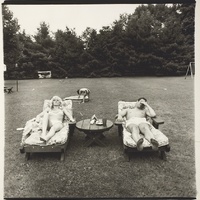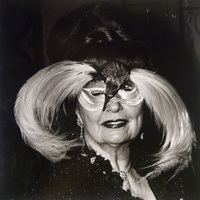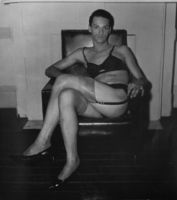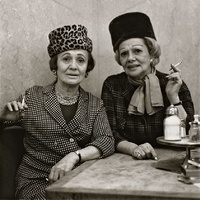About The Photographer
Diane Arbus is one of the most influential photographers of the twentieth century. At a time of great social upheaval and change, she looked past the perfect nuclear family ideal to the outskirts of society, bringing a voice to the voiceless and an opportunity for understanding. Her photographs focused on the individual rather than the backdrop. What made her so special was her ability to capture an entire essence in a photograph, a singular moment of a whole existence.
Arbus was born in 1923 to a wealthy New York City family. The effects of the Great Depression did not reach her family like it did much of the nation, yet rather than feeling proud, she felt disconnected and privileged. Arbus felt her family’s fortune to be “humiliating” especially at a time when money was a scarcity. She later described her environment as an “unreality” and for the rest of her life, she sought the realness she was denied in her childhood. When she was only fourteen years old, she met the nineteen-year-old Alan Arbus. Though the budding relationship was forbidden by her family, the young couple persisted and when Diane was eighteen, they married. Her new husband was sent off to the Signal Corps in World War II where he was trained in the art of photography. It was he that then introduced his wife to photography, and from there, her career took off. They began working together in commercial fashion photography for her family’s department store. Eventually, their work appeared in fashion magazines such as Vogue and Harper’s Bazaar. However, this was not the kind of life Diane had dreamed of. Fashion proved to be still so “fake” compared to the reality that she craved. In 1957, she quit styling photo shoots with her husband. Instead, the next year she enrolled in classes at the New School in New York under Lisette Model, who soon became a close friend and mentor. She realized her new student’s talent for recognizing the soul of a subject.
In Arbus’s new career, she chose to take the path of a documentary photographer. Instead of seeking to create art with her camera by setting up staged subjects and instances, she went out into the real world to search for beauty. And in her case, she found it in some very unlikely places. She started off by photographing subjects that seemed interesting to her. Arbus spent a lot of time thinking about herself, which critics of her and her work have found to be exhausting. However, her eternal quest for conflict in her photograph led to extremely interesting images. Sometimes her subjects would be outright wretched, such as in her photograph Masked Woman in a Wheelchair, which features an elderly woman in a frightening Halloween mask. Other times her subjects were simple, as in the case of A family on their lawn one Sunday in Westchester, N.Y., but the way Arbus played with light and timing caught moments that humanized the seemingly perfect world than one might otherwise catch. In the latter photograph, the mother and father are pictured eating and drinking, lounging on chairs while their child plays alone in the background. This photo hearkens back to Arbus’s own childhood, displaying some signs of trouble in paradise. Though the photo is only capturing one instant, one could make the case that the child is being neglected by his selfish parents, and the father has his hands over his eyes seemingly in anguish. For Arbus to create this narrative with three stationary subjects tells a lot about her ability to find a story in a photo.
Some of Arbus’s more shocking images take on almost a circus-like frenzy. For example, the shot The Human Pincushion, Roland C. Harrison, MD displays just that, a man with giant needles sticking through the skin of his face, chest, and arms. Obviously a shocking image, especially back in the early 1960s, her image tells a story about her subject but somehow does not alienate him. While the purpose is indeed to shock her viewers, there is also an intimacy between the camera and Mr. Harrison that prevents fear of him. Jack Dracula, the Marked Man is similar in this aspect. With tattoos covering all of his visible skin, he is quite an intimidating character. However, his posing along with the backdrop of the grass almost makes the setting seem like a picnic rather than a horror film.
Principally, Arbus worked in a 35mm film format. She would stroll the streets of New York looking for something interesting to photograph. There is a bit of emotional distance between her and her subjects in her earlier photographs. These were often of a grainy quality, which is likely why in the early 1960s she switched to a Rolleiflex camera. With this was taken her most famous images. The medium-format camera allowed better quality images and the twin-lens reflex feature stopped her from having to block her sight by bringing the camera up to her eye; rather, the camera would be at waist level and she would look down into the viewfinder to take her pictures. Another artistic aspect of the Rolleiflex was that the film was in the shape of a square, allowing her to break away from landscape style shots that our eyes are so used to.
Personally, Arbus’s photos resonated with me because they depict such interesting subjects. While a regular portrait can be done artfully, this photographer’s work has an inherent difference because she chose to show people who were cast out of polite society. At a time in America when conformity was so important, she threw away her privilege and took to the grimy streets of New York City to do something different with her life. The 1950s and 1960s in America idealized values of politeness and homogeneity. A picture of a mother, father, two children, and house with a picket fence was the norm, and more than that was expected. However, during Arbus’s time, this perfect lifestyle was debunked by the counterculture movements and war protests of the day. While she did not focus on these events, she was obviously influenced by the rising celebration of diversity in society. It seems that she lived at the right time as this straying from the status quo happened in the prime of her career.
Unfortunately, this would be cut short in July 1971, when Arbus, suffering from severe depression, took her own life at the young age of 48. Her work had increasingly been celebrated and recognized in the years leading up to her demise, and the fame proved to be too much. Arbus, who had spent her whole life defying expectations of society, felt the pressure of fame and money that comes with success in the art world. One of her last projects had been to photograph mentally disabled adults at a residential center in Vineland, New Jersey. These photos were different from her other work in that they often had mists and blurs present, a departure from her otherwise rather sharp style. At first, Arbus found her new photos exciting in that they represented a change from her norm. They were more tender than what she usually photographed, and she even wrote to her then ex-husband Allan saying “finally what I’ve been searching for.” Soon, though, Arbus changed her mind. She felt that she had little control over the images and grew to hate them. Perhaps it was not a loss of control of the images, but a bigger aspect of her life that caused this change, especially so close to her eventual death by her own hand. Nevertheless, this last photo series was just as true as her others, despite the imprecision.
Diane Arbus’s work remains as important, relevant, and polarizing today as it was 50 years ago. Much in the way the Humans of New York social media account addresses social issues through normal people on the street, Arbus’s documentary style told a story of hardship and intrigue, without the need for any captions. Arbus once said of her own work “I really think there are things nobody would see unless I photographed them.” A long way down the road from her beginnings as a commercial fashion photographer, Arbus paved the way to see the world differently, if not just to clearly see the world. She documented what the rest of the society purposefully hid away. Critics of her work have said over the years that “we see Arbus’ work more with our minds than with our eyes.” While they are visually intriguing, her photographs exist to make people think and consider lives that have taken a completely different path than their own.
Bibliography
Bosworth, Patricia. Diane Arbus: A Biography. New York: W.W. Norton, 2005.
"Diane Arbus." International Photography Hall of Fame. Accessed September 27, 2018. http://iphf.org/inductees/diane-arbus/.
Lubow, Arthur. Diane Arbus: Portrait of a Photographer. New York, United States: Ecco, an Imprint of Harper Collins Publishers, 2017.
Mac Austin, Hillary. "Diane Arbus." Jewish Women's Archive. Accessed September 27, 2018. https://jwa.org/encyclopedia/article/arbus-diane.
Schultz, William Todd. An Emergency in Slow Motion: The Inner Life of Diane Arbus. New York: Bloomsbury, 2011.



